The Amateur Mycologist - Puerto Varas/Petrohue River - Part 2
These posts are not for foraging. They are intended for entertainment and intellectual satisfaction only. These posts are not a field guide nor comprehensive in any way - their accuracy is not assured in any way. Do not eat wild mushrooms unless you are a professional, have substantial professional assistance or have a wealth of personal experience with a specific species. Do not make any foraging decisions based on these posts. To do so could be dangerous or life threatening.
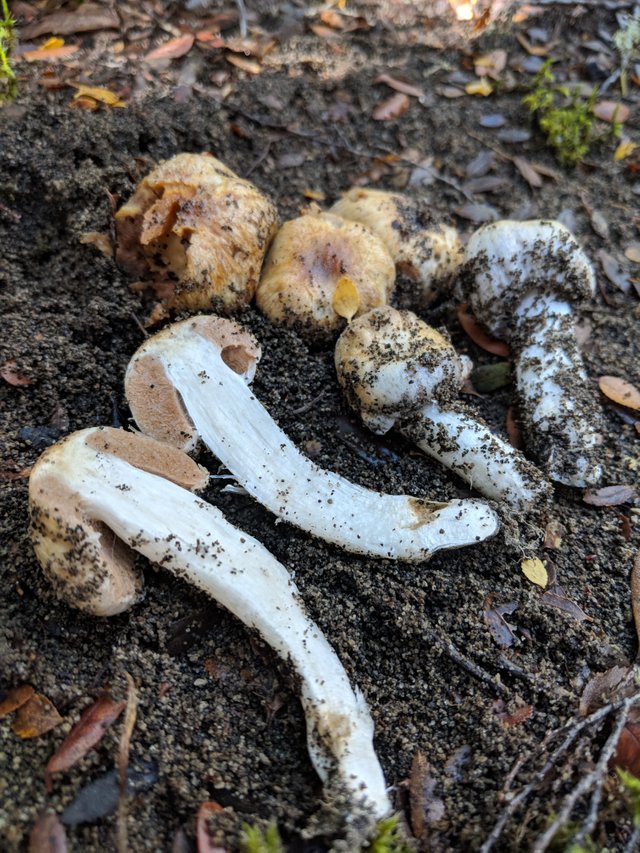
What is going on here?
All throughout the trip through Chile we encountered our fair shair of Cortinarius mushrooms. As we talked about last time the Cortinarius genus comes in a wide variety of shapes and sizes. All over the world Corts are known for being robust gilled mushrooms with cortinas and rusty brown spore prints.
For instance, C.iodes below, with its purple cap, star spots center and rusty brown print, found in a NYC park.
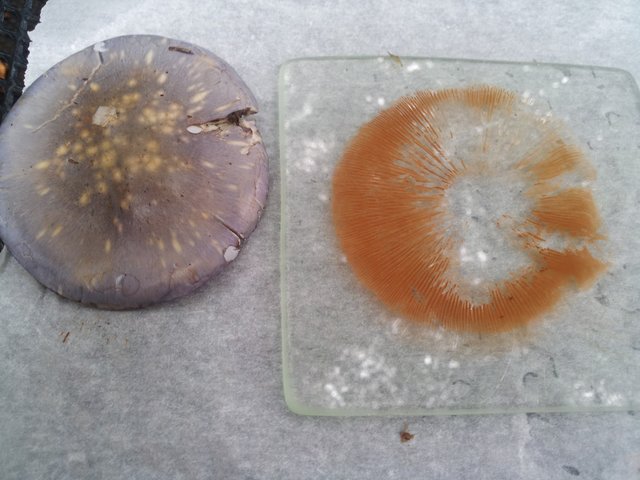
Or compare this generic brown Cort from Chile, where you can clearly see the gills in the middle specimen.
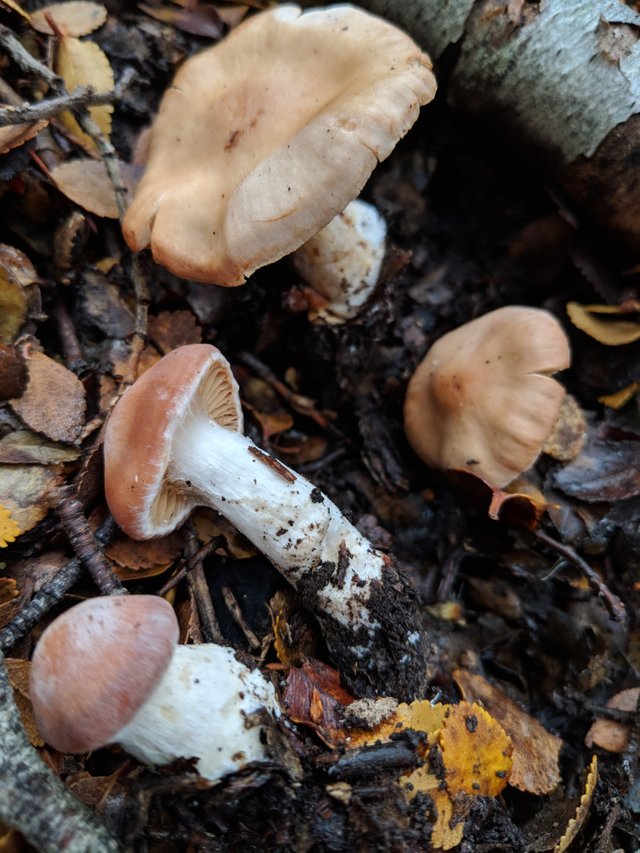
Now go back up to the top and compare all three pictures and the difference should be readily apparent.
This is Cortinarius albocanus and it is very different than most Corts. Unlike the other Cort mushrooms pictuted here - unlike most Corts in the world - C.albocanus has a very strange spore surface.
Let's zoom in on that feature.
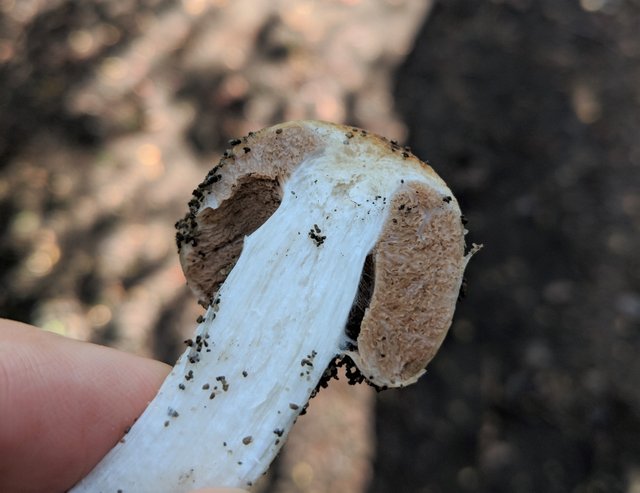
There are no gills, at least not in any conventional sense.
Instead, C.albocanus has a kind of sponge-like spore bearing structure. It is still a basidiomycete, but the "gills" look quite different than you'd expect.
ENHANCE
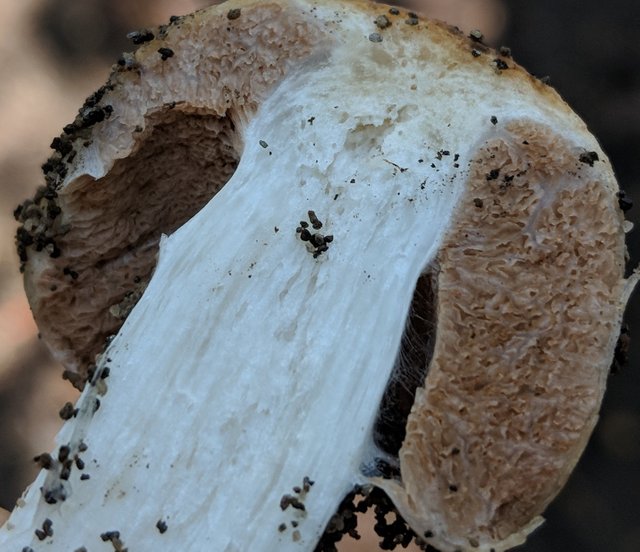
Up close you can see the strange ripply texture of the spore bearing material.
It is not the same as the pores of a bolete or a polypore, but rather almost a brain like series of curls and bends. You can also see the wisps of cortina left behind on the right of the photo down by the edge of the cap connecting to the stem. It looks like cobwebs.
I find it particularly strange to look at the underlying part of the gills on the upper left of this zoomed in photo.
ENHANCE

See how the fertile surface seems to be made of ripples of weird mushroom flesh?
Presumably it is from those wrinkled surfaces that mature spores will be expelled.
As far as I can tell this Cort is found only in the Southern Hemisphere, so I am not likely to see it again for some time, if ever. It may not be the most colorful of the mushrooms we found, or the most explosively odd in a general sense. But, from the perspective of a fungi enthusiast, this is probably the weirdest overall mushroom I saw in Chile. It highlights the immense diversity present in the Fungi Kingdom that a mushroom like this even exists. Clearly the gill structure it happened upon has provided it with adequate evolutionary advantage, and yet it is fundamentally different from most others one might encounter.
The area around Petrohue lake was not the most fruitful mycological foray, but we did find some beautiful, if opaque specimens. Take the very pretty brown Mycena below.
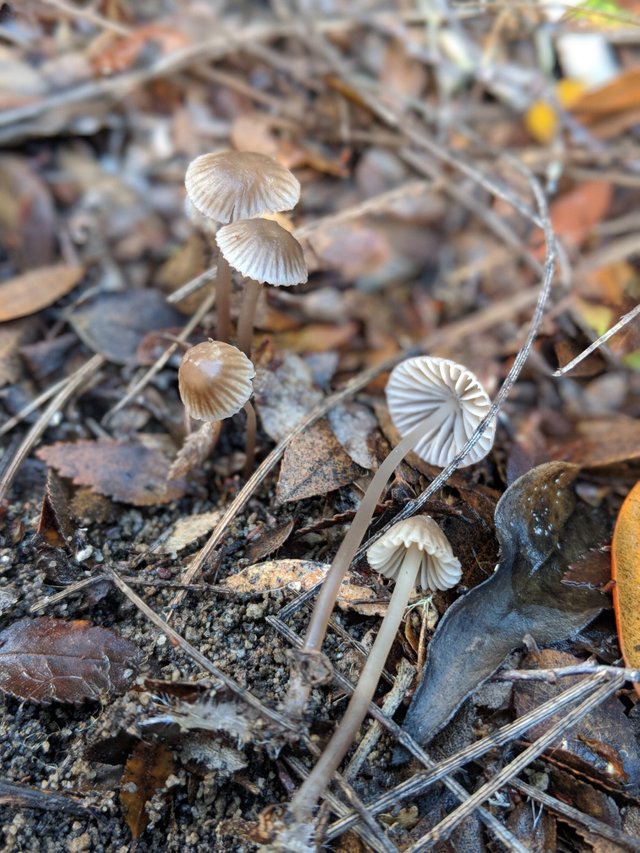
I have no idea what these are but they highlight an important lessen I am currently putting into effect with my new fungorium.
It's important when collecting mushrooms for long term collections that you actually get a fairly numerous group. Getting only one individual cap of any given species really isn't much use. It doesn't give a sense of the mushroom at different timings of maturity, nor does it leave much material to be tested at a later date.
Of course there are times where you really don't have much choice in the matter - and we'll see that in the future of these Chile posts when we find a black Entoloma and some other singletons. But, whenever possible, more specimens from the same growth medium is always preferable.
Now lets turn to the natural beauty segment of the post.
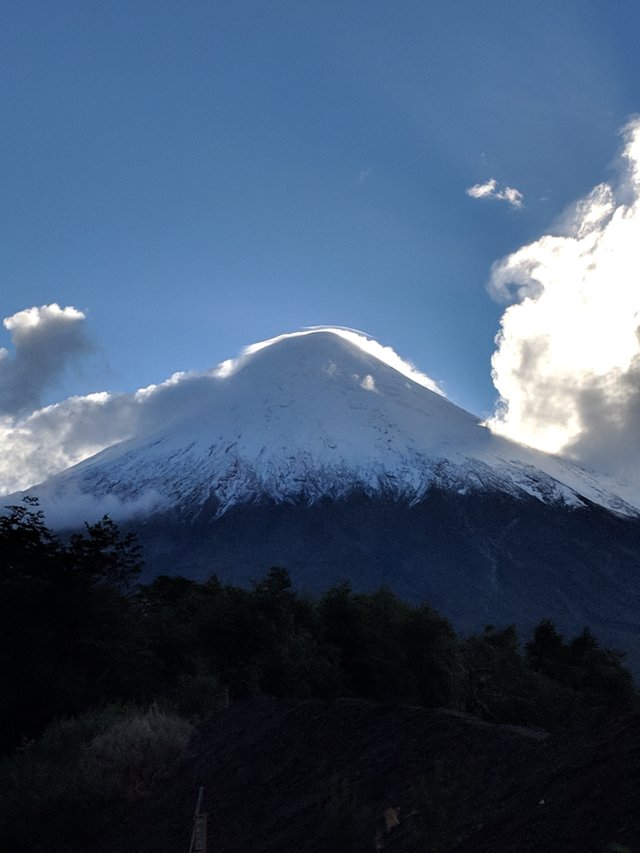
Behold Osorno Volcano!
Capped in a passing cloud, the cone of the volcano towers in the blue sky.
Osorno has not erupted in over a century, but when it does boy oh boy does it explode.
A number of the volcanoes we encountered im Chile are knowm not only for their explosive potential, but also their intense lahars, which leave their mark on the landscape. Take a look.
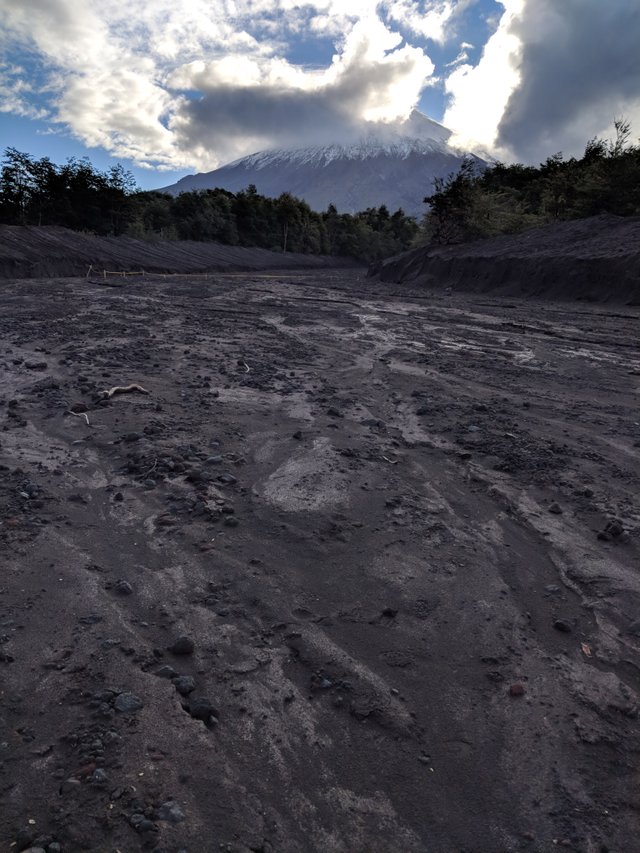
Here is the wide furrough of volcanic material expelled from Osorno in the last eruption.
Like a paved road carved straight into the landscape the remnants of the old lahar flow cuts a channel all the way to the base of the volcano. You can imagine the intense power and violence of an eruption which spews molten rock and steaming water down its sides with enough force to leave a semi-permanant scar across the face of the Earth.
But from the immense violence of volcanic eruption there comes a wide variety of life.
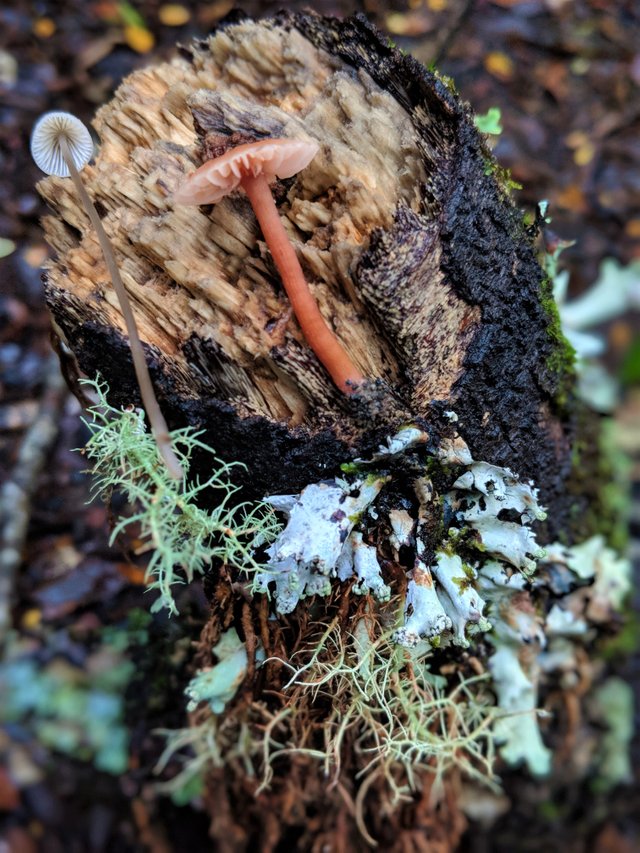
The material spewed from a volcano tends to be very high in minerals and nutrients which plant, and fungal life can thrive on.
The area surrounding the volcano is filled with vibrant forests, alive with a wide array of plant life, including thousands of Murta berry bushes, lichens of several types, and, of course, numerous fungal species.
In this photo, in addition to two types of lichens, you see a delicate Mycena mushroom of unknown identity, as well as a Laccaria mushroom.
Laccaria is a wide genus known, in part, for its flexible stems which do not easily break or snap when twisted but hold together almost like a weak rubberband.
Apparently, this particular species is absolutely dogged in its sheer will to survive.
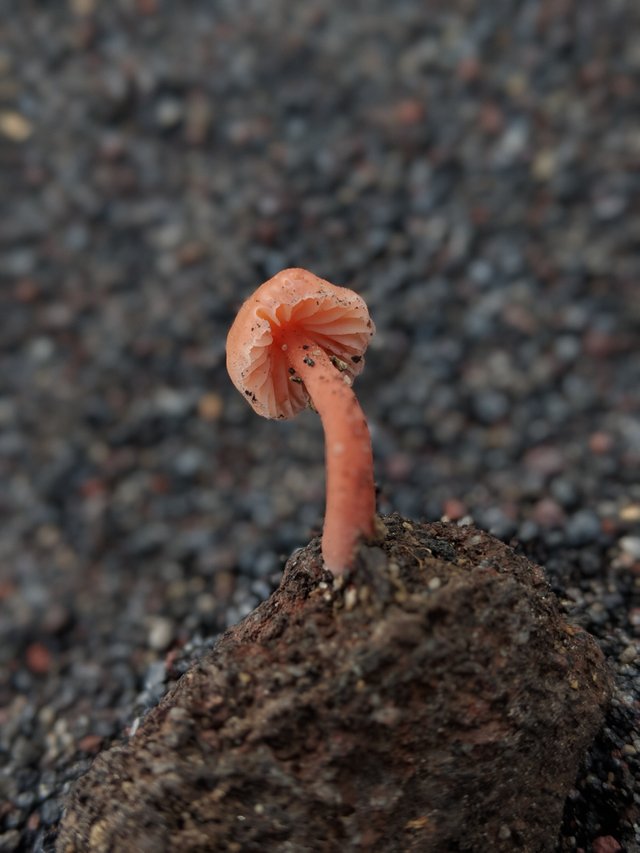
That, right there, is a mushroom growing straight out of a volcanic rock.
This was a first for me, and for most of the people who saw it. Usually we see mushrooms growing on a wide variety of substrates, whether it be wood, soil, plant or animal life, or even other mushrooms. But the idea of a mushroom growing out of a rock is about as strange as finding a fish walking down the street.
And yet, there it is - a Laccaria mushroom growing directly out of a volcanic rock without any other apparent source of nutrients. This means the mycelium has woven itself through the porous rock's surface and sucked out subtantial nutrients - sufficient nutrition to create fruiting body to further the species.
It can be tempting to anthropomorphize non-human organisms, and generally I try not to. But I'm hard pressed to look at this mushroom, thriving in the harshest home I can imagine, and not think of him as a determined, plucky little fella doing his best to get by. In doing so his mycelium is working to break down the hard volcanic rock and turn it into even more aggreable soil, a process consistently at work in and around Chile's many volcanoes.
Next time we move further north through Chile and encounter some of the most beautiful Fungi in the world.
All Photos Are My Own
Information Sources:
- Primary sources were several of the mycologists I went on the trip on in this case, whose photos and identifications I had access to in preparing this post.
- Cortinarius albocanus (E. Horak & M.M. Moser) Peintner & M.M. Moser - Observed by Giuliana Furci on Mushroom Observer
- Kuo, M. (2010, December). The genus Laccaria. Retrieved from the MushroomExpert.Com Web site
- Kuo, M. (2010, December). Mycenoid mushrooms Retrieved from the MushroomExpert.Com Web site
- Volcan Orsorno on Wikipedia
- Todos Los Santos Lake on Wikipedia
- Petrohue River on Wikipedia
Please support @Steemstem and the #Steemstem community, dedicated to bringing and supporting high quality STEM related content on Steemit.
Let me clarify what I mean by "support." There are a number of good options.
Head over to the steemstem discord channel and the #steemstem tag and start talking with the other users involved in the community, commenting and upvoting on their submissions.
If, like me, you can hardly find time to post your own material once a week, then consider joining the steemstem autovote trail, which you can inquire about on said discord channel.
Or, if, like me, time is very difficult to give to the community, then consider making a delegation. Presently, and for the last half year, I have delegated a third of my SP to the @steemstem account.
Great looking mashroom
Hey friend, I'm very amazed with your post. Are you chilean? I'm a venezuelan living Chile and also biologist. I started in Steemit just one month ago to do some science communication as you do! I would take the time to read all of your post. Congrats!
I'm not from Chile, but visited the country with a large group of naturalists and mycophiles and took lots of photos. You should connect to the @steemstem crew on discord, an awesome group to know for STEM related content.
The brown Mycena looks very much like those little umbrellas they put in drinks )
I love the addition of the natural beauty segment. Very majestic.
The doggedness of the Laccaria is even sharper when juxtaposed to its pinkness. It's like Reese Witherspoon in Legally Blonde :D
Hahaha - that's pretty perfect
wow really happy that I get to share all these finds with you, and learn even more about the amazing world of fungi. The photos are fantastic, loving the close ups and that volcano is amazing, and the mushroom growing out of the volcanic rock I am very impressed with that indeed. Thank you @dber
Thanks for checking it out @trucklife-family!
The very best replica from CSI series :)
Epic volcano view
Can I eat them? would I be so High ...?
I resteem and upvote anything related (quality posts of course) to lahars or volcanoes.
Amazing photos of orsono! Thanks for the beautiful photos. Cheers!
Amezing i read your post
This post is one in a million...... Really scientific in all ramifications.
Well done @dber
Congratulations @dber! You have completed some achievement on Steemit and have been rewarded with new badge(s) :
Click on the badge to view your Board of Honor.
If you no longer want to receive notifications, reply to this comment with the word
STOPDo not miss the last post from @steemitboard!
Participate in the SteemitBoard World Cup Contest!
Collect World Cup badges and win free SBD
Support the Gold Sponsors of the contest: @good-karma and @lukestokes